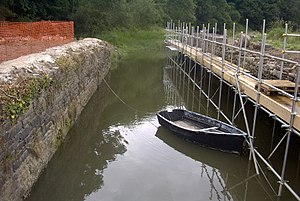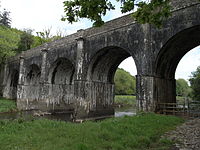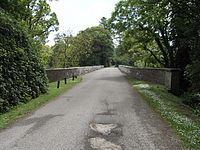Rolle Canal

The Rolle Canal (or Torrington Canal) in northern Devon, extends from its mouth into the River Torridge at Landcross six miles southwards to the industrial mills and corn-mills at Town Mills at Rosemoor, Great Torrington[1] and beyond to Healand Docks and weir on the Torridge, where survive the ruins of Lord Rolle's limekilns, upstream of today's Rosemoor Garden.[2]
Town Mills were built by Lord Rolle and were powered by a stream which flowed past his seat of Stevenstone to the east of Great Torrington and also supplied water to the canal. Rosemoor and North and South Healand farms were part of Lord Rolle's Stevenstone estate on the east bank of the Torridge.
Description
The canal comprises a sea lock at Landcross, a 60-foot inclined plane at Weare Giffard and an aqueduct of five arches over the River Torridge at Beam.[3]
At the terminus of the canal at the limekilns at Rosemoor a leat supplies the canal to ensure a constant water level, which channels-off water from the River Torridge at Healand (or Darkham) Weir,[4] rebuilt in 1837.[5]
 |
 |
 |
 |
Lime kilns
The canal terminates beyond "Rowes Moor" (now known as Rosemoor) at a group of lime kilns designed by James Green. These consist of five large pots, each one 14 feet in diameter and 20 feet deep, arranged consecutively in a straight line along a wharf. Railway tracks led from the canal up a ramp to the top of the pots where a flat area existed for the storage of lime and fuel (culm/anthracite) pending burning. An office for the site forman was situated at the upper level. These kilns are derelict in 2013.[4]
History
The construction of the canal started in 1823 as a private venture financed largely by John Rolle, 1st Baron Rolle (died 1842), one of whose principal seats was at Stevenstone, east of Great Torrington. He was the largest landowner in Devon and owned much land around Torrington, including the estate of Beam, where continues to exist a mansion house which had served as a home for junior members of the Rolle family. Other shareholders in the company were William Tardrew of Annery, Monkleigh and Richard Pine-Coffin of Portledge,[6] who owned land on which the northerly section of the canal was constructed between the Rolle estate of Beam and the end of the canal at Landcross.
The canal was built largely at the landowners' own initiative, though they obtained a private Act of Parliament eventually to assist their purposes in 1835.[7] The idea for the canal had been proposed originally by Lord Rolle's father Denys Rolle but for various reasons nothing had come of those plans. The function of the canal was to import limestone from Wales to be burnt with coal, also imported, at inland kilns to make lime fertiliser which would greatly increase the fertility, and thus the value, of agricultural land. Marland Clay, mined south of Torrington, was to be exported through the seaport of Bideford, at the estuary of the River Torridge, for the making of bricks.
More generally the canal was to link the industrial mills at Great Torrington, some of which were owned by Lord Rolle, to the seaport of Bideford on the River Torridge. James Green was employed as the lead engineer.[1] Lord Rolle laid the foundation stone of the aqueduct in a ceremony which included the firing of a cannon, which unfortunately exploded, causing injury to a man by the name of John Hopgood, whom Rolle compensated with a year's salary.[1]
A stone tablet on the north parapet of the Beam Aqueduct is inscribed:
The first stone of this aqueduct was laid by the Right Honourable John Lord Rolle, Baron Rolle of Stevenstone in the county of Devon, on the 11th day of August 182(1?) in the presence of the mayor, corporation and feoffees of Great Torrington and other persons assembled to witness the commencement of the (word chiselled out) CANAL undertaken at the sole expense of his Lordship. James Green Engineer.
The canal was completed in 1827 at a cost of between £40,000 and £45,000.[3] The canal shared many design features with the Bude Canal, unsurprisingly as the Bude Canal had partly inspired the scheme and shared the same lead engineer. Similarities included the use of trains of tub boats and of canal inclined planes rather than locks. The inclined plane was powered by a water wheel. The canal received its water supply from a weir on the River Torridge which also supplied two mills with power.[8]
Leased to George Braginton
In about 1852, some ten years after Lord Rolle's death, the canal was leased to George Braginton (1808–1886) of Moor House, St Giles in the Wood, (the centre of the Rolle's Stevenstone estate) several times Mayor of Great Torrington, described in 1830 as "canal agent to Lord Rolle, and Portuguese vice consul for the Devonshire coast, in the Bristol channel".[9]
When the lease to George Braginton ended is unknown, but certainly no later than 1865.[10] On the termination of the lease, control of the canal passed to Lord Rolle's adoptive heir Mark Rolle (1835–1907), a younger son of Lord Clinton.[11]
Closure and sale
In 1871 the canal was closed and sold to the London and South Western Railway to form the trackway of the proposed new railway from Bideford to Torrington. At one point the railway company wished to abandon the project but at Mark Rolle's insistence the railway was built.[11] The track followed the canal in several stretches, not sitting within the former canal but on elevated ground beside it. The railway was dismantled during the 20th century and the trackway now forms part of the Tarka Trail cycleway.
Some parts of the canal are still visible today, including the Beam Aqueduct, now a viaduct carrying a new entrance drive to Beam Mansion, now an adventure holiday centre. The sea lock also survives, without its gates, as do parts of the inclined plane. The Annery kiln near Weare Giffard lies close to the old canal, between it and the River Torridge, and is visible from the Tarka Trail. The canal has been designated a Devon County Wildlife Site.[12]
Restoration

The Beam section of the canal is still owned by the heir of Lord Rolle, Lord Clinton and is managed by the family's management company, Clinton Devon Estates, still possibly the largest private landowner in Devon.
Parts of the canal have been under restoration since 1988.[13] Clinton Devon Estates plan to restore the Beam estate section of the canal after 2013, and in 2000 completed restoration of the old stone bridge which took the old driveway from Beam Mansion northward over the canal, which passes under through a narrow tunnel.[14] Some work on the sea lock was carried out in 2006 involving re-pointing and rebuilding the eastern wall.[12]
The canal in fiction
The Beam Aqueduct is referred to as the "canal bridge" in Henry Williamson's Tarka the Otter.[15]
Location
- Location: 50°56’56"N, 4°8’46"W
Outside links
References
- ↑ 1.0 1.1 1.2 Russell, Ronald: 'Lost canals and Waterways of Britain', page 96 ISBN 0-7153-8072-9
- ↑ Rosemoor Garden – Events: Bideford People
- ↑ 3.0 3.1 Industrial Archaeology Aids to recording (6) page 76
- ↑ 4.0 4.1 http://www.therollecanal.co.uk/index.php/the-canal/lime-kilns/
- ↑ http://www.therollecanal.co.uk/wp-content/gallery/1800s/healandbluesml.gif
- ↑ http://www.therollecanal.co.uk/index.php/history/who/
- ↑ The Statutes of the United Kingdom of Great Britain and Ireland. George Eyre and Andrew Strahan, Printers to the King's Most Excellent Majesty. 1835. p. 1084. https://books.google.com/books?id=B6JUAAAAcAAJ&pg=PA1084.
- ↑ Leone Levi, ed (1865). Annals of British Legislation. Smith, Elder. p. 381.
- ↑ London and Provincial New Commercial Directory, London, J. Pigot & Co. (1830)[1]
- ↑ Hadfield, Charles: 'The Canals of Southwest England' page 139-140 ISBN 0-7153-8645-X
- ↑ 11.0 11.1 Paget-Tomlinson, Edward (2006). The Illustrated History of Canal & River Navigations 3rd edition. Landmark Publishing Ltd. p. 189. ISBN 1-84306-207-0.
- ↑ 12.0 12.1 "Canal comes back to life". North Devon Gazette. 17 August 2006. http://www.northdevongazette.co.uk/northdevongazette/news/story.aspx?brand=NDGOnline&category=news&tBrand=devon24&tCategory=newsndga&itemid=DEED17%20Aug%202006%2010%3A10%3A36%3A667. Retrieved 2008-11-01.
- ↑ North Devon Gazette, 17 August 2006
- ↑ Brass plaque affixed to bridge: "Clinton Devon Estates: Beam Canal and Bridge renovated Millennium 2000", with Clinton coat of arms above
- ↑ Russell, Ronald: 'The Country Canal' ISBN 0-7153-9169-0, page 124
- Scrutton, S.: 'Lord Rolle's Canal' (Susan Scrutton, 2006)
- Hughes, B.: 'Rolle Canal and the North Devon Limestone Trade' (Edward Gaskell Publishers, 2006) ISBN 1898546924